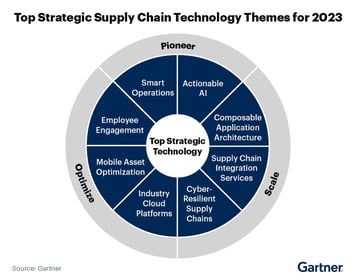Industry Cloud Platforms a Growing Trend, Says Gartner®
Robert Recknagel - April 12, 2023

Even though the manufacturing sector has historically been reluctant to embrace change, demand for cloud-based supply chain management applications and services is growing.
By 2026, about one-third of supply chain organizations will use Industry Cloud Platforms (ICP) to accelerate their digital business initiatives, according to the recently published Gartner report, Top Trends in Strategic Supply Chain Technology 2023. The trend toward ICPs is being driven as the complexities of both business and technology continue to increase and supply chain organizations look for more outcome-based engagements with their solution providers.
“Supply Chain technology leaders developing their technology innovation strategies for the next three to five years must:
- Maintain and optimize supply chain operations by maximizing human and cyberphysical asset performance through employee engagement, mobile asset optimization and investing in smart operations.
- Help scale the business and become more agile and flexible by constantly evaluating and adopting advanced digital technologies like industry cloud platforms (ICPs), composable application platforms and enhanced cybersecurity.
- Support new business and operating models by pioneering new forms of engagements through actionable artificial intelligence (AI) and strategic supply chain integration services,” says Gartner.
What we believe this means for manufacturers is that supply chain digitization is opening up new opportunities to manage supply chains in a smarter, more connected way—from digital production and network planning to real-time route optimization.

More agile production planning
Speed is an essential component of an efficient production line. The flexis HYRBRID architecture covers the entire product lifecycle from planning to delivery. Standardized modules such as sales and operations planning, order slotting, detailed scheduling and sequencing can be easily combined to significantly increase the efficiency of their installations.
These modules enable businesses to move away from reactive decisions and towards proactive supply chain strategies. For example, a prescriptive algorithm can find inefficiencies on the factory floor, saving money and time once the problem is resolved. Workflows with predictive analytics could be used to transform previous customer orders into intelligent demand forecasts, adjust production logic accordingly, and thus minimize excess inventory. In the logistics sector, information can be transferred instantaneously from maps into an application so that route planning can be adapted in real-time to changing traffic situations.
Benefits over traditional scenario planning
Consider a traditional production planning scenario in which simulations are run on several different systems and solutions are calculated overnight in batch processes on mainframes. This is time-consuming and, in some cases, can even lead to supply chain delays when planners lack the information they need in the moment because it’s still being processed.
A calculation that runs through the entire production for the next three months—or even an entire year—down to the parts level requires an enormous number of resources. Computing power in this model isn’t scalable, which means that all these resources must be permanently available in-house at all times, tying up capital and staff, even though this kind of comprehensive analysis may only happen a few times a year.
In the cloud model, you only pay for the computing power you actually use, when you use it.
Greater accessibility of data
The ability to access data remotely is one of the basic facts of the cloud. Intelligent solutions allow supply chain managers to view real-time production and other data at any time, from any location, to make smarter, more informed decisions. Cloud solutions link the availability of personnel, material and tools, allowing planners to visualize the entire operation with one dashboard. This is especially important for manufacturers with multiple locations across different geographies or those with complex, decentralized organizations.
Because the cloud connects different applications and functions across departmental boundaries, it can also help reduce or eliminate data silos. Instead of risking one-sided production conditions due to missing order information, production plans that don’t match up with transport flows or downtime due to slow procurement of raw materials, planners can take timely countermeasures by efficiently accessing all networked information in real-time. The process brings together sales, production plants, and production planning, as well as logistics and purchasing, to ensure stable production programs, avoid capacity bottlenecks, and provide smooth production logistics.
“A modular and composable approach makes it easier for ecosystem partners to deliver value-added capabilities that complement or add depth to industry cloud offerings,” says Gartner. “Such a holistic, modular approach makes bringing technical and business innovations from one industry to another easier and faster.”
Gartner, Top Trends in Strategic Supply Chain Technology 2023, Christian Titze, Dwight Klappich, Rick Franzosa, Noha Tohamy, Brian Schultz, Rishabh Narang, 9 March 2023.
GARTNER is a registered trademark and service mark of Gartner, Inc. and/or its affiliates in the U.S. and internationally and is used herein with permission. All rights reserved.
LATEST POSTS
- Understand Circular Economy in The Manufacturing Industry
- How Can Industry 4.0 IT Integration Be Achieved Smoothly?
- The Significance of Order Sequencing in Discrete Manufacturing
- How to improve your Supply Chain Management: The Power of Control Towers
- Optimizing Human Resource Scheduling in Manufacturing: A Technological Approach

